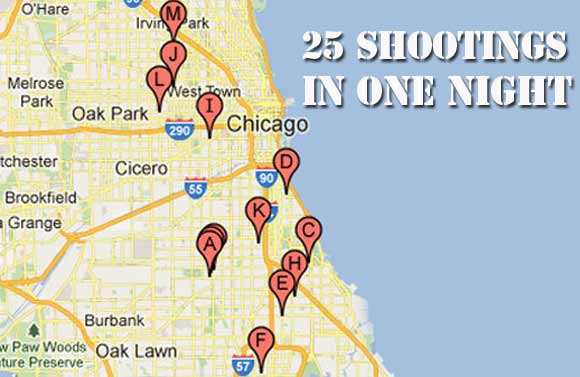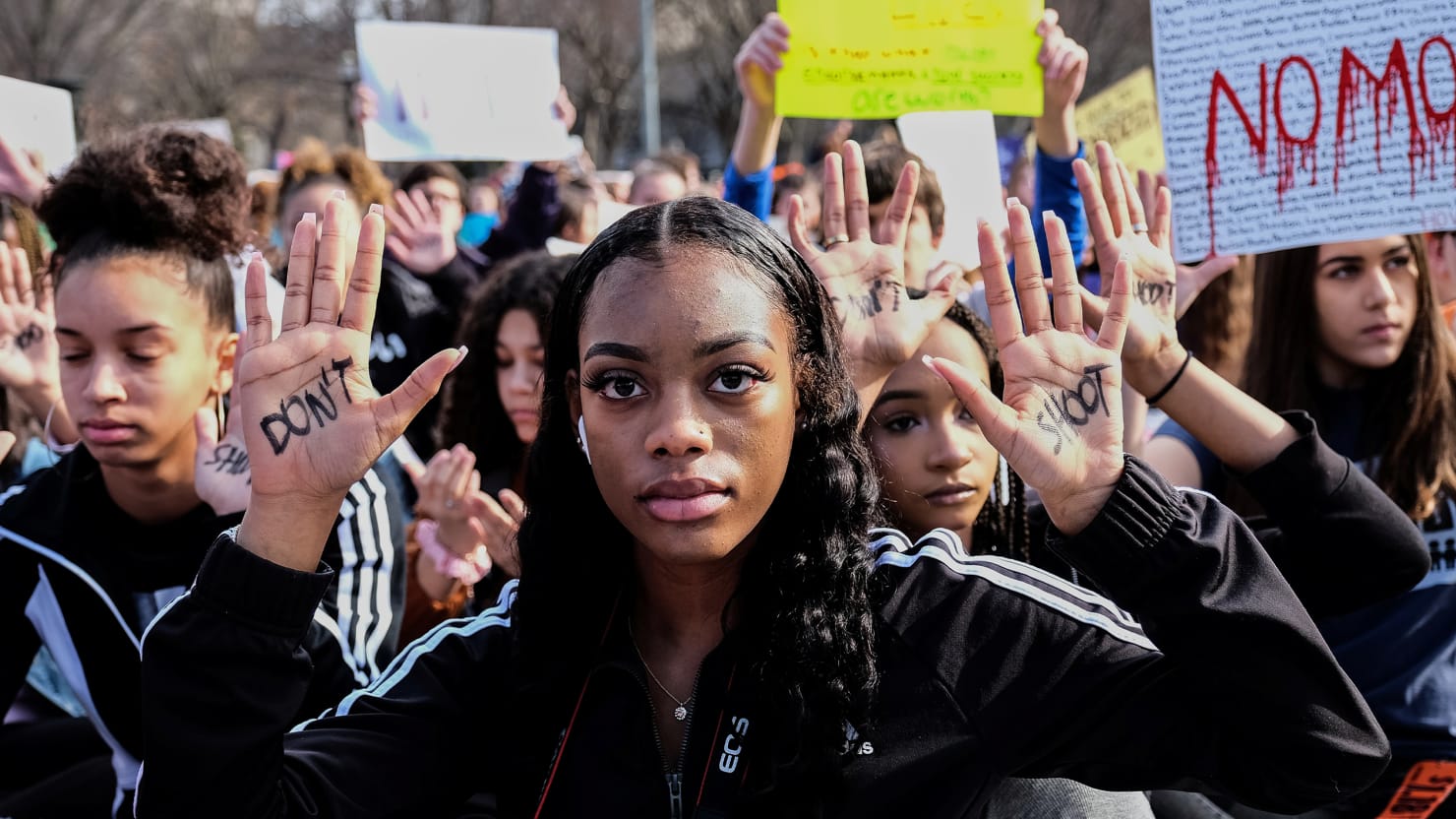To Reduce Urban Gun Violence, the US Needs
A Marshall Plan for Impoverished Communities
Mark Karlin / Buzzflash
(July 9, 2022) — Before the onslaught of massacres, weekend local news in most urban areas used to be nicknamed “the knife and gun club.” That is because the maxim, “if it bleeds, it leads,” was considered to draw more viewers, which increased advertising revenue, which raised profits.
In most cities the graphic coverage usually was of Blacks having been shot in “Black belts” around the nation. Now, massacres, still primarily white (although that is changing as we’ve recently seen), up the viewership for both local and national news.
However, the reality is that the number of Blacks and Browns shot to death or wounded is disproportionate to their percentage of the population.
Recently the CDC released a report with significant findings that bolster this reality. A 2022 Johns Hopkins Bloomberg School of Public Health article noted from the findings that, “New Report Highlights U.S. 2020 Gun-Related Deaths: Highest Number Ever Recorded by CDC, Gun Homicides Increase by More Than One-Third.”
Notably, in 2020, gun-related homicides disproportionately impacted Black people more than their white counterparts, especially Black males. Young Black males represent two percent of the total U.S. population but accounted for approximately 38 percent of all gun homicide deaths in 2020.
Black children and teens face alarmingly high rates of gun victimization. More than half of all Black teens (15-19) who died in 2020 — 52 percent — were killed by gun violence.
Black males ages 15 to 34 were over 20 times more likely to die by gun homicide than their white counterparts. There was a 49-percent increase in the number of gun homicides among Black females compared to 2019.
It’s true that major gun control organizations and groups back an initiative “Invest in US” that focuses on Black communities that have been disinvested. Its website has the subtitle, “Communities of color have the solutions to end gun violence.”
The reality is that the only reason Americans are seeing less news about the “knife and gun club” is that weekend coverage is being crowded out by massacres.
The headline of a July 7 Washington Post article succinctly states, “With little outcry, Chicago’s bloody weekend eclipsed Highland Park toll”:
No new counseling resources were announced this week on this city’s impoverished South Side, even after a man was shot to death in broad daylight, feet from a playground, days before July Fourth.
There are no crowd-sourced charity drives raising millions for victims’ families in Chicago, where the holiday weekend death toll reached at least 10 with 62 injured — numbers that exceed the toll from a July Fourth parade shooting in nearby Highland Park, Ill.
In that affluent lakeside suburb, the violence was an anomaly. Here, it is a grimly regular occurrence.
Admittedly, there are aggressive efforts to fund and implement violence intervention services and some efforts to supply support networks in gritty minority neighborhoods, but without massive federal funding, the scope of “positive results” is limited. That is because the gun problem in disenfranchised minority neighborhoods is complicated, particularly related to two of many factors— destitute areas and a virtually unlimited availability of legal and mostly illegal guns.
There are people working their hearts out to prevent gun violence in these areas, but there is too much gunfire and too few financial opportunities. Dramatically reducing urban Black violence calls for nothing less than an economic and educational overhaul, a very challenge to the heart of laissez-faire capitalism.

So much of the fervent efforts of the gun control organizations avoid this towering reality and believe that the gun fusillade in such areas can be stopped through “interventions” or recognizing that gun violence is “a threat to an entire community’s health.” This is, of course, true but hardly breakthrough thinking.
On the “Invest in Us” website, there are listed several laudable goals, but none of these will work without transforming communities of “gunfire zones” into safe places to live. “Intervening” through a few experimental programs, funded by some public and some foundation funds, does not have sufficient financing to “save” these communities one Black or Brown male at a time, however effective for the lucky individuals who are chosen for a project.
Journalists Lopez and Wu addressed this in a July 8 NYT email simply entitled “everyday violence”:
Since a gunman killed seven people at a Chicago suburb’s July 4 parade, more than 160 people have died from other gun homicides across the country. In Chicago alone, at least 10 people were killed in multiple shootings during the holiday weekend.
These everyday killings received far less attention than the mass murder at the parade. But they are the standard for American gun violence: More than 95 percent of gun homicides this year have been shootings with one to three victims.
Using statistics from the University of Chicago Crime Lab (which does work with issues affecting Black community violence), the journalists note how only a few areas, sometimes just four or so square blocks, dominate the rampant gun violence.
One crucial point is that violence tends to be highly concentrated: A small sliver of blocks — just 4 percent in Chicago, for example — can account for a majority of shootings in a city or a county.
Many of the people in these blocks live in terror. The sound of gunshots is common, sometimes coming multiple times a day. Parents worry that their kids could be next, and young people fear for their own lives. As Jomarria Vaughn, a 24-year-old Chicagoan, told this newsletter: “I’m scared. I have my guard up all day.”
This map of shootings in Chicago shows the concentration. Shootings are rare in much of the city, particularly on the wealthier North Side, but not on the poorer West and South Sides.

Getting to the crux of the problem, the article states:
It is difficult to talk about gun violence without talking about race, because Black Americans are most likely to be the victims of shootings. Poverty explains part of the disparity, since Black people are more likely to be poor. But individual poverty is not the full explanation.
Black Americans are also less likely to live in communities with strong institutional support. Exclusionary housing policies and discrimination have pushed Black Americans into segregated neighborhoods. Both governments and the private sector then neglected these neighborhoods, leaving people without good schools, banks, grocery stores and institutions.
This kind of economic and social neglect, which experts refer to as disinvestment, fosters violence.
These islands of desperation need to be transformed through an urban Marshall Plan.
Crime itself devalues these relatively concentrated areas of urban destitution,
The relationship also goes the other way, Roseanna Ander, executive director of the Crime Lab, told us: Violence can perpetuate disinvestment. Business owners do not want their shops, restaurants and warehouses in violent neighborhoods. People do not want to live in places where gunshots are fired daily. And governments shift resources away from places that officials deem lost causes. It is a vicious cycle.
But the reality is that unless the national government does indeed invest in a Marshall Plan for the gun-plagued zones, there will be no solution.
The gun control movement fell over backwards, for the most part, praising the “weak cup of tea” bipartisan gun control, which offers little in the way of the humongous task of transforming those blighted communities or reducing the islands of human firing ranges. Pilot projects may be successful for a limited number of individuals, as the Crime Lab has shown, but non-profits don’t have the money to transform neighborhoods.
Furthermore, little will change unless the gun industry is brought to heel.
Mark Karlin has been Editor of BuzzFlash for more than 20 years. He was Chairman of the Illinois Council Against Handgun Violence — and helped keep Illinois at the forefront of gun control in the ‘80s and ‘90s, including the Land of Lincoln being the only state avoiding a pre-emption law on guns and preventing carry-concealed for 12 years.
Posted in accordance with Title 17, Section 107, US Code, for noncommercial, educational purposes.
